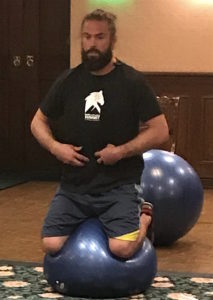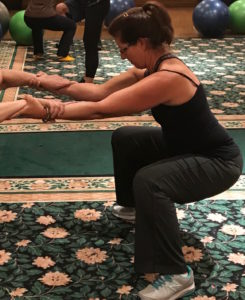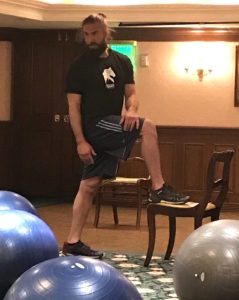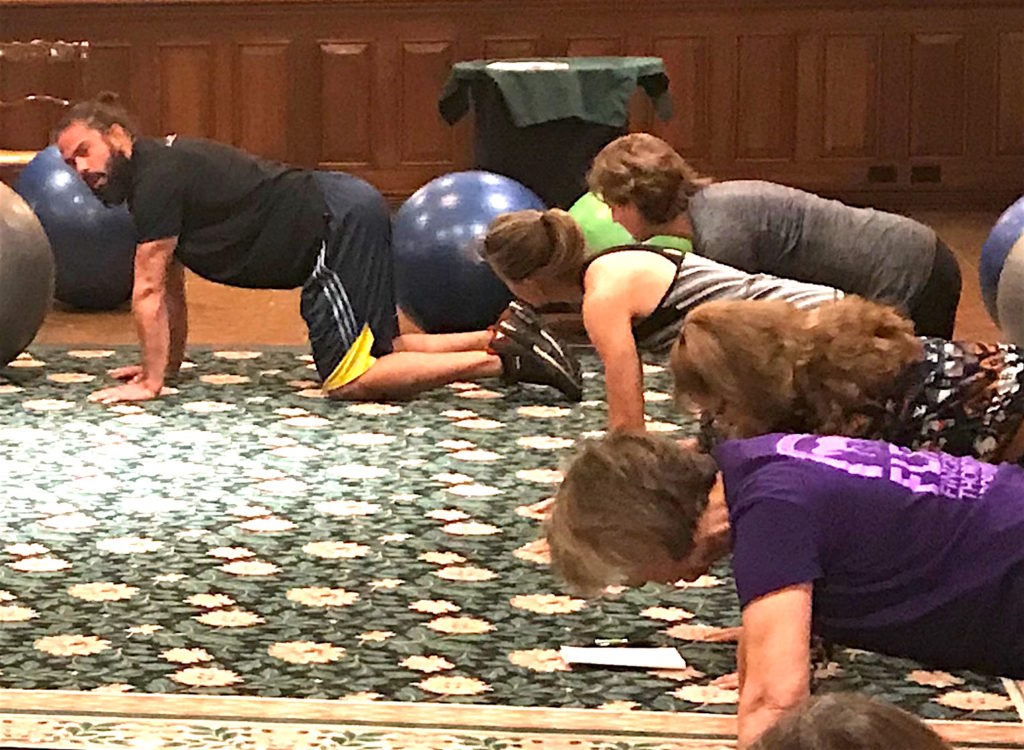
Amy Skinner
Editor’s Note: Amy Skinner is a regular guest columnist and has been a horse gal since age six. She works with owner/operator Jim Thomas as a trainer at Bar T Horsemanship where she rides and teaches English and Western. She also maintains Essence Horsemanship. Skinner has studied at the Royal Andalusian School of Equestrian Art in Spain, with Buck Brannaman, Leslie Desmond, Brent Graef, and many others.
Skinner attended the Rider Strength & Balance elective conducted by trainer David Stickler at the Best Horse Practices Summit. Stay tuned for the video next month!
Skinner writes:
People tend to get hung up on the horses’ fitness and forget about their own, so it’s a topic I

David Stickler emphasizes core strength and balance
feel like I’m constantly emphasizing to riders as I teach. At the Best Horse Practices Summit in Durango, Colorado, there were many presenters passing along pertinent and interesting information. Everything from the horse’s feet to his brain was covered. But what stuck with me the most was David Stickler’s Rider Fitness Class.
This class was music to my ears.
Stickler majored in Exercise Science at Fort Lewis College in Durango, Colorado, and has taught strength and yoga classes for years. The 33-year old began his early morning class in the Strater Hotel surrounded by exercise balls and a group of twenty eager women in yoga pants.
“Your horse responds and adjusts to every imbalance that you carry,” he said, as he stressed the importance of a balanced and fit rider. “You as a rider become an extension of your horse’s nervous system. His proprioception now includes you.”
He encouraged riders to begin an exercise program that promotes functional strength and flexibility. That means not just doing exercises that tone or lengthen muscles, but working muscles in a functional and healthy way.
 “Just being strong or flexible isn’t gonna help if it doesn’t relate to your riding,” said Stickler. Don’t wait until you’re already experiencing stiffness or pain in the saddle, but be proactive by establishing a preventative wellness program to develop longevity in the saddle, he said.
“Just being strong or flexible isn’t gonna help if it doesn’t relate to your riding,” said Stickler. Don’t wait until you’re already experiencing stiffness or pain in the saddle, but be proactive by establishing a preventative wellness program to develop longevity in the saddle, he said.
Stickler stressed the importance of maintaining flexibility in the hamstrings, hip flexors, and groin. These the muscles are the most shortened from riding and keeping them limber will help keep the rider’s seat deep and connected to the horse. Any tightening raises the rider’s center or gravity and inhibits good communication with the horse.
He walked the class through a series of stretches for the lower back, hip flexors, groin, and hamstrings, including a simple Sun Salutation. He stressed the importance of working and stretching muscles in groups that work together as a more holistic approach to flexibility and strength.
“Muscles that fire together wire together,” said Stickler.
Maintaining a strong core is paramount for a balanced seat. It helps the rider follow the horse’s movement without getting left behind, and also helps prevent injury. Stickler showed participants how to work their cores and practice finding their balance with exercise balls (which simulated their horses). Students learned to adjust their center of balance and work their muscle groups to stay balanced without tensing.
 “Understand where your center is and your horse can make adjustments without you interfering,” David said.
“Understand where your center is and your horse can make adjustments without you interfering,” David said.
Horseback, your center of balance is constantly changing. Being able to adjust is paramount. Squats on the Bosu Ball instead of the ground emphasized functional strength and balance. He also demonstrated jump squats – (squat down, jump up, and land in a squat position) which teach your body to land in precarious spots, lets your hips work to support you, and keeps your joints soft.
When riders are stiff and lacking strength, they may mount in a way that makes the horse uncomfortable, Stickler explained. Rider fitness is essential, he said, to the horse’s health.
“You owe it to your horse to develop strength and stability so you can mount without having to sacrifice his balance and stability and his overall long term health.”
The exercise prescribed for better mounting involved a simple step-up onto a chair, alternating sides. If you want to take it further, David showed students how to step up and add a twist through the core for a more advanced strengthening and balancing challenge.
From strengthening to stretching
After a ride, stretching increases your recovery time. Tight riders create tight horses. “Horses respond pressure to pressure. Where you’re tight, he has to compensate and it creates imbalance in his body,” he said, adding that equine chiropractors sometimes treating animals for issues caused by rider imbalance.
By the end of David’s class, riders walked away with a clear picture of how their fitness and flexibility affects their horse. They left with specific exercises to develop this functional strength and inspiration to become their best selves for their horses.

Hello Maddy & Amy –
Thank you for this article!
Was David’s class recorded? Would we be able to see it in its entirety?
I hope so. It would be a great addition to my routine and also those of my students!
Thanks Again,
Sara
Sara, thanks for your comments. Yes! David’s class will be an online video early next year. Thanks for your support and enthusiasm!